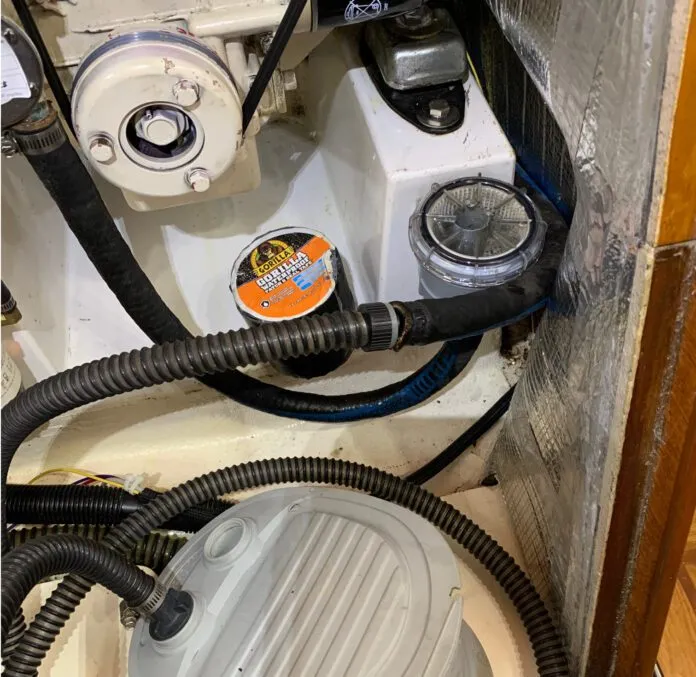
It was another spectacular summer day as we released the dock lines and once again escaped life ashore, the trusty diesel humming beneath our feet. The weather forecast promised sunshine and moderate winds. My wife and I were away uncharacteristically late, something that seldom occurred on our boat. Friends were in a beautiful anchorage ten miles away, cocktails and dinner awaiting our arrival. We wanted to be there! Light wind rippled the clear blue water as we passed the breakwater, a plethora of boats skittering about like water bugs on a lake. A busy afternoon at the marina with a promise of another relaxing weekend on the water.
UNUSUAL ALARM
Suddenly an alarm shattered the idyllic scene, one that I had not heard before! A quick scan of the engine panel showed a bright red warning light for engine temperature, the accompanying gauge showing well above normal and rising rapidly! Not good. I quickly shut down the diesel and scrambled to roll out the genoa to maintain steerage in the crowded channel. Fortunately, the breeze was just forward of the beam and we could maintain course on a tight reach.
HOT ENGINE
Carey took the helm as I dove below to open the engine compartment. A wave of heat billowed into my face as I removed the companionway stairs. The trusty diesel seemed somewhat forlorn, apologetic for causing such a problem. The heat exchanger was too hot to touch, I wasn’t going to open the coolant cap to check fluid levels. The raw water strainer’s clear plastic top showed no debris, and empty of water as well. Strange! I’m somewhat fanatical about engine maintenance and knew the raw water pump was almost new and probably not the cause.
ASSESSING THE PROBLEM
I instructed Carey to momentarily start the engine. No seawater flooded into the strainer. Not good! The strainer was mounted so that the top lip of the bowl was at seawater level. I knew that if I took the screw top off the strainer water should quickly flood to the top of the plastic bowl. I did, and it didn’t! Damn! A quick check of the hose between the raw water intake and strainer showed no points of collapse. Something was plugging the intake. I wasn’t going to be able to fix that right away and so climbed back into the cockpit to assess our predicament.

We were about a mile from the safety of our berth at the marina, it was mid afternoon on the first day of a four-day jaunt into the Canadian Gulf Islands, and friends were awaiting our arrival. The breeze was steady and from the right direction. It was a very short discussion. We’re on a sailboat, lets go sailing! The main was hoisted and joined the genoa as we heeled into the breeze. The afternoon quickly vanished in a glorious three-hour reach to Bedwell Harbour. Although the wind went very light for a while, we managed to sail to a vacant mooring buoy and secure the boat. Diagnosis and repair could wait, cocktails, dinner and good company under a setting sun took precedent.
The next morning, I re-assessed the problem. Aboard Natasha, our 1978 Islander Bahama 30, we had a Beta 20 diesel mounted on a sail drive, a system I had installed nine years before and was very familiar with. This reliable combination allowed for quiet, nearly vibration-free motoring when we lacked wind. The raw water intake was through the sail-drive leg protruding under the hull, much like the water intake of an outboard motor. What could have plugged the intakes on both sides of the leg? I had no intention of going for a swim in the 10 C water if I could help it. I started the Beta momentarily and put the prop in reverse, hoping the wash would force the obstruction away from the inlet ports. No luck.
UNBLOCKING A SEACOCK INLET

In past years we had the old Volvo MD7A diesel with a shaft and fixed prop. When we faced a water flow blockage, I would close the through-hull seacock and remove the intake hose. With a metal probe (usually a long icepick) I would carefully open the seacock and start poking at the obstruction, usually kelp, as water started to geyser in. Always an exciting and wet experience! But I couldn’t do that with the sail-drive leg. The openings for water intake were just too far down the leg from the seacock mounted on the upper part of the leg inside the boat. No way to push the obstruction out. I needed something else to remove the obstruction from the leg, but what would work? I needed to put my thinking cap on!
CREATIVE USE OF DINGHY PUMP HOSE
On Natasha we’ve always had an inflatable dinghy for going ashore. The dinghy came with a foot pump for inflation. Although not identical in diameter, the hose of the pump lined up reasonably well with the raw water hose I had removed from the intake port of the raw water strainer. I taped the two hoses together using plenty of “rescue” tape (something every boater should carry).
Starting carefully, I pressurized the raw water intake hose leading into the leg. Nothing happened other than to pressurize the hoses, no sound of bubbles under the hull. Careful pressure eventually led to stomping on the pump. Suddenly the pump went slack and I could hear air bubbles escaping under the hull! Success! I quickly shut the seacock at the leg before seawater flood up into the foot pump. The two hoses were separated and the raw water hose reconnected to the raw water strainer. Opening the seacock quickly filled the bowl with seawater. Starting the engine showed excellent water flow. We were back in business. I never did see what it was that had plugged the intakes.
NYLON ADAPTER FOR FUTURE BLOCKAGE TROUBLESHOOTING
With this new successful solution, I now carry a nylon adaptor to connect the raw water intake hose to the dinghy air pump hose. Two properly sized hose clamps are included in the “emergency kit,” should this occur in the future. No need for the rescue tape. I’m ready! This set up would also work well for the standard engine through-hull intake hose. No need to get wet as water pours into the boat.
ADDING AN ADDITIONAL SEACOCK AND WATERFLOW SENSOR

As is typical of this type of boating issue, they always seem to occur at critical times, not when you have the luxury of time to come up with a solution. At next haul out I installed a second raw water through-hull near the engine, with proper seacock. A “T” connected the new through-hull to the seawater strainer hose. Should this problem crop up again, particularly around marinas and other tight places, I can simply open the seacock on the back-up intake to keep the engine happy until I can sort out the blockage.
I have also installed an Aqualarm waterflow sensor with alarm indicator on the engine control panel. If the intake is blocked in future the alarm will sound long before a blocked water intake becomes an issue at the engine, allowing ample opportunity to shut down before overheating occurs. The diesel is too valuable, both as a reliable friend, as well as a financial expense, should we not catch such a failure in time.





































Lucky it didn’t put you in a tight spot! Thanks for sharing the low-flow sensor. I added that to my list of future improvements.
I’ve installed the same alarm. It will not only alert you to a clogged intake, any obstruction to flow such as a corroded mixing elbow or a failed impeller will set off the alarm. It may even warn you if you forgot to open the seacock:) Better to know of problems immediately, rather than waiting for the engine to warn that it’s about to warp it’s head.
I have used this method for years to clear air conditioning pump inlets. I have four AC units with three through hulls supplying raw water flow for them. With the sea cock closed, I remove the bowl of the strainer, empty it and clean it of the choking debris picked up in the water where our boat is berthed, and reassemble the strainer. With the sea cock still closed, I disconnect the inlet line at a convenient location where I can use an attachment that came with the pump to join the pump outlet to the dissimilar inlet line from the through hull, with pressure applied to the pump before opening the sea cock, and then with vigorous pumping by my wife when I open the sea cock, we listen for bubbles under the boat. The pump is elevated above the level of the through hull, limiting the back flow of water to the pump. Sometimes I must take over the foot pumping. After reassembling the lines and starting the air conditioner raw water pump, if I do not get the expected water flow, I loosen three of the screws on the front of the pump until all air is expelled and a slight spray of raw water occurs. Tightening the screws on the face of the pump ends the process, except for cleaning up any water left in the bilge.
Hello Gary. I just replaced a hose system on a Sabre 386 today, extending the raw water intake hose from the through hull to the raw water strainer into a loop. It’s hard wall and when removed from the strainer, springs into a vertical position. The top of the hose is then above the waterline. The top batten of the main sail is the perfect fit, width and length, to now poke down the hose and clear any plug once the through hull valve is opened. The hose and foot pump would also work without letting water into the boat. The trick is the hard wall hose, it’s ridged enough that it doesn’t have to be held up while working with it. Thanks for the comment.
Could you comment on the installation of the aqualarm flow detector? I could not find anything in YouTube
My apologies for not responding sooner Luis. The installation is fairly simple. Mine is placed between the through-hull and the raw water strainer, it’s the only place it would fit. But it could go anywhere from through-hull to raw water pump. The challenge will be water flow, establishing that you have enough that the alarm will not trigger at idle. With my small Beta 20 there simply wasn’t enough water flow so I installed a on-off switch on the alarm panel. Once I’m up past 1,600 rpm I flip the switch. When I throttle back (coming into port) the alarm sounds, I turn the system off. I now have confirmation that it works. I also chose the dual alarm system from AquaFlow, it also has a heat sensor on the exhaust hose. It’s the always-on back-up. I believe the AquaFlow web site has that information as well.
Great article and good thinking. I will also prepare a kit for “just such an emergency.” Also impressed that you did not allow a pesky mechanical malfunction to interfere with cocktails and dinner!
SAIL boat first, pesky engine (that I really admire for reliability) second! I’ve had that second through-hull for a year now and feel far more assured that I have a back-up should something plug up the primary source of water. Thanks for the comment.